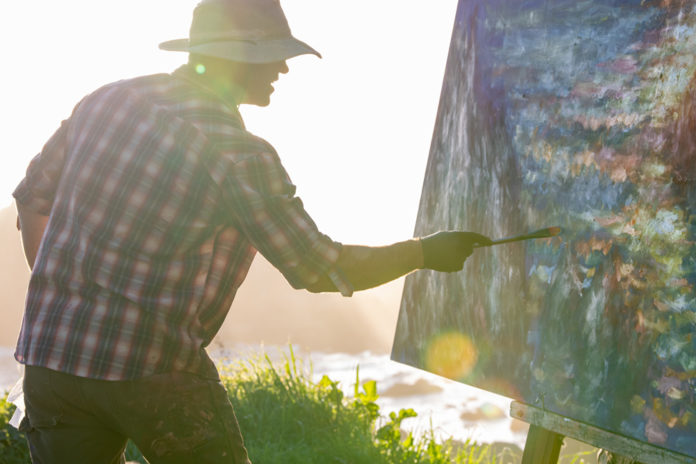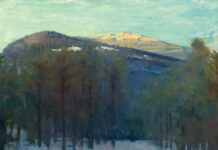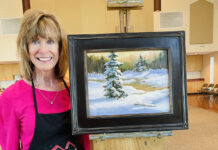Ryan Jensen fills 9-foot paintings with landscapes done on location. Here are the challenges, how and why he does it, and how being a Marine has informed his path as a professional artist.
A 40 x 60-inch canvas he saw in a local art store lured oil painter Ryan Jensen into the world of big paintings. “I wondered what it would be like to take that outside to paint — how would I even put it on my easel,” he recalls. “Well, I’d never know if I didn’t try, so I decided that the next time I went in that art store, I was going to get it.”
The format was daunting. That’s what Jensen liked about it. “If the subject or size intimidates me, I have to identify what I’m afraid of and figure it out,” he says. “I feel a rush of adrenaline at the thought of the challenge and I commit to doing it.”
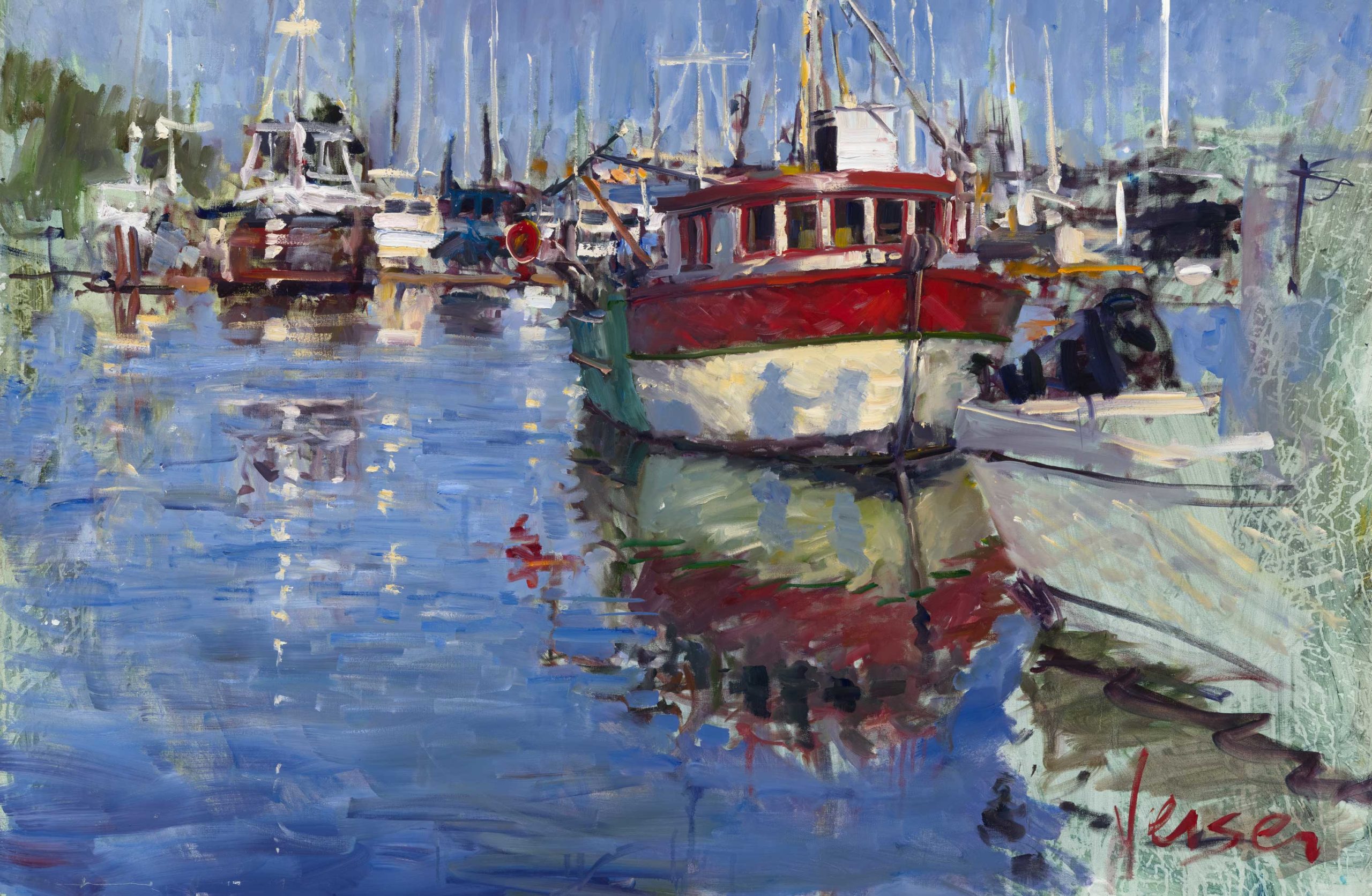
Jensen knows a little bit about commitment. The child of a graphic designer and a fine art painter, he was a devout draftsman growing up. “There are piles of my sketchbooks at my mom’s house,” he says. He was also a dedicated athlete in school. But he learned the true meaning of commitment and dedication when he joined the Marine Corps.
“As a painter, I have a certain discipline that was birthed in the Corps,” Jensen says. “I’m not quite sure if anyone understands the dedication that I put forward on my art-making. I look at hundreds of paintings online every day, talk to my mentor, and paint. Just talking about painting gets me really souped up because it’s my mission. When I was a Marine, my mission was to be the best Marine I could be — to stay healthy and keep my guys alive. Now my mission is to do a great painting and get better every day at it. If I don’t paint a good painting, then I have to learn from it. I’m not allowed to get too discouraged about it. And I’m not allowed to slow down.”
Discipline and dedication weren’t the only qualities Jensen brought home from the Marine Corps. He says it also honed his observation skills, patience, toughness, and social skills. Only the call and responsibilities of marriage and children dissuaded him from serving out the full 20 years of a military careerist. Luckily, Jensen says he enjoys the love of a supportive wife who championed him both as a Marine and an artist.
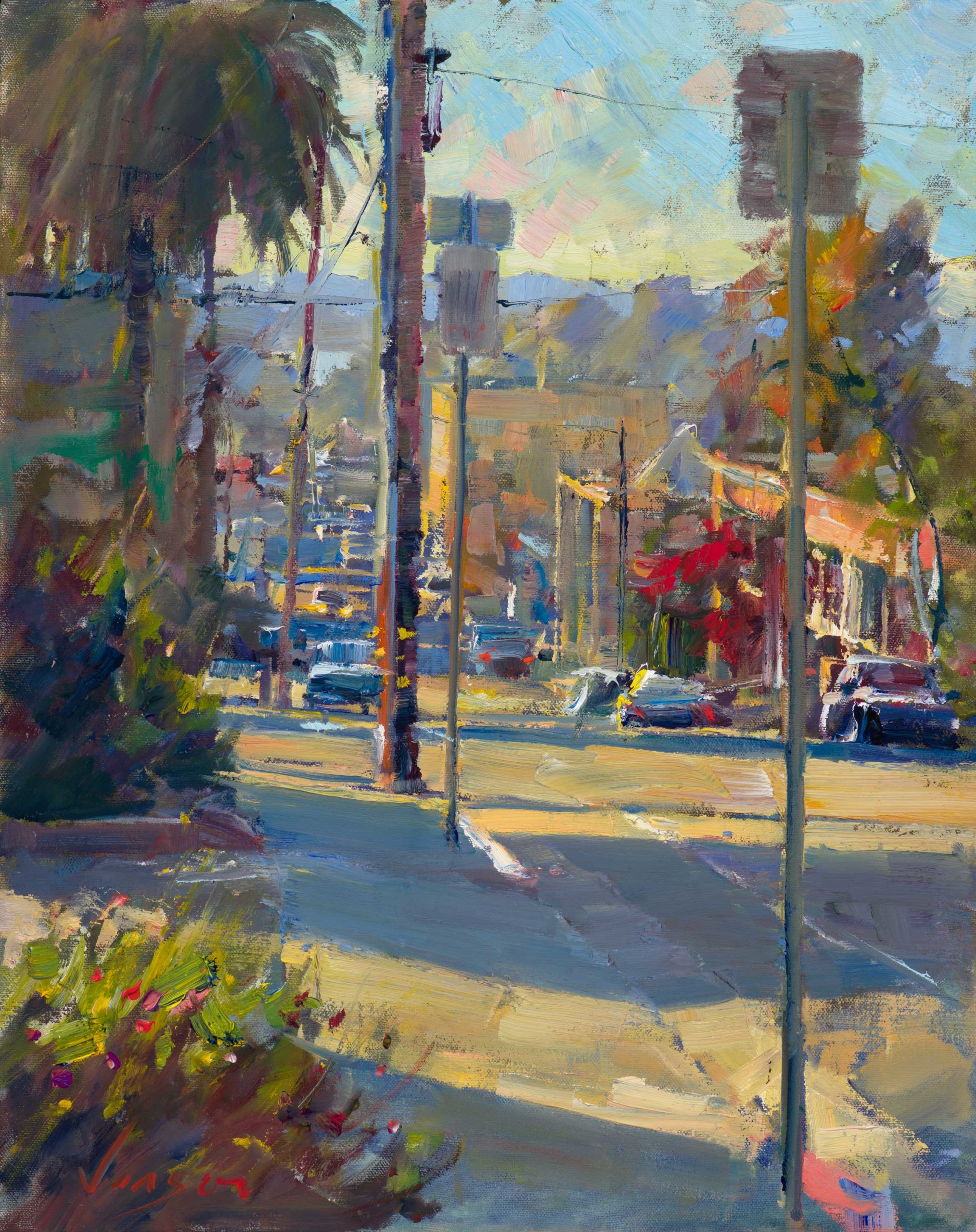
PART OF THE EARTH
Jensen was a machine gunner in a sniper unit, seeing action in both Iraq and Afghanistan. His artist eyes stayed with him even in the most dangerous situations. “In the mornings when the sun was coming up, and in the evenings, there would sometimes be this amazing light in Afghanistan,” he recalls, “scenes so beautiful they looked like a cartoon. All that warm light could appear so exaggerated. I wished I were armed with my camera more than my gun. Still, I did get my fair share of photos, including some amazing black-and-white ones.”
Observation skills weren’t a nicety — they were a matter of life and death. “You have to be really good at your job,” Jensen says of his work in the Marines. “You have to be working harder than the enemy. You have to be conscious of not setting a pattern, not doing the same patrol at the same time every day. You have to be set up in a sniper hide before the sun comes up. Yes, you have to be observant as you look through the scope of your M40 rifle, but it’s more than that. You have to notice if the bird in the tree behind you isn’t chirping one morning like it usually does. You have to pick up on that. One person in the sniper unit has to fill in the observation log to find subtle differences in the pattern, in the environment. A sniper is a part of the earth.”
Pair that kind of scrutiny with an eye for color and shape and you have an extremely observant artist. Pair that level of observational ability with Marine Corps-level dedication and you get Ryan Jensen.
After his honorable discharge, Jensen sought a new course. “I tried to be a wetland surveyor,” he recalls. “I got to ride in a quad and do wetland restoration projects, but in the back of my mind there has always been this burning desire to see if I could make it as an artist.” He went back to school, but Jensen knew he was “doomed” when he took his first painting class. “I knew I would get obsessed with it,” says the artist. “When I respond to life with colors on the palette, it becomes me; it’s almost a spiritual experience — very healing and nourishing for my soul. I get glimpses of why I’m supposed to be here.
“Pretty quickly I found that school got in the way of my painting, and I was already far behind in my career as an artist. I knew what it would take and I knew I’d have to do it full time if it was going to be a profession, so I dropped out of school. Today I constantly think about how to market my paintings and support my family doing it. I have two kids and a wife; I have to be successful in this. I have to be selling at least a painting a month.”
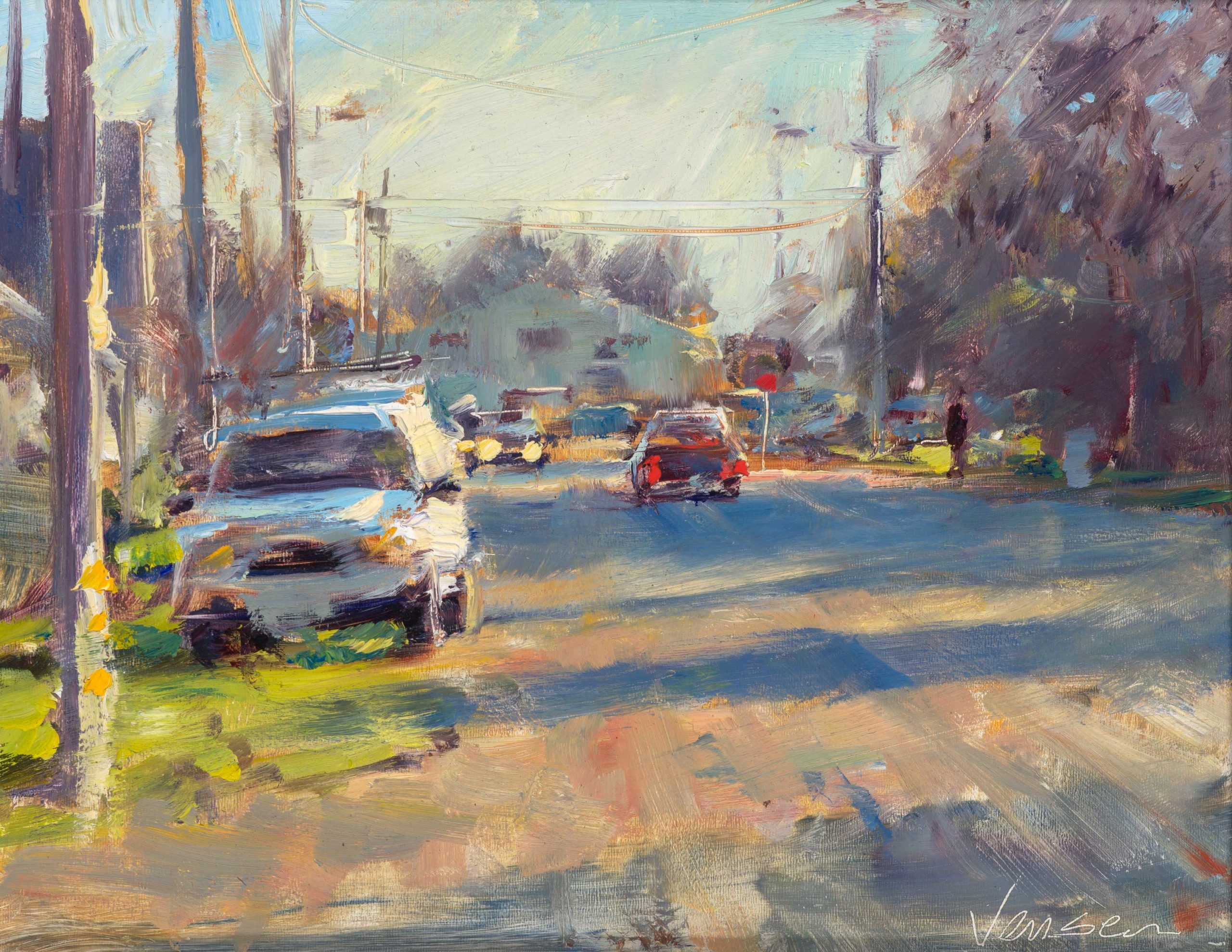
SETTING UP TO PAINT BIG
The back of Jensen’s Ford F-150 “looks like a paint tube graveyard,” and the challenge of painting on big canvases pulls Jensen’s entire body into the process. “When I’m looking for a scene, I’m really looking — crouching down to view different angles, looking low, sitting on a bucket for a different view,” he says. “My brain and hand now work with my whole body. I’m on my knee. I’m standing up. I find it’s not healthy for me to work on the same size canvas all the time. My real goal is to grow as an artist, and I don’t feel like I can do that if I paint the same size. It’s a rush to stand there painting a 9-foot canvas. People are watching, and the excitement shows in the brushwork.”
Location is critical when dealing with such a large format. Jensen says he sometimes finds himself driving around for hours looking for a paint spot. The opportunities shrink a bit when a big canvas must be accommodated. “With a nine-footer, you have to slow down and stay put,” he says. “The hardest part is getting it out of the truck and getting it set up. It’s taken me four painting sessions to complete each of the 9-footers I’ve done so far.”
Jensen found that the docks near his home in Blue Lake, California, were a good spot for painting a big piece. Fishing and the ocean feature prominently in the area’s history and makeup, so paintings of ships are more than appropriate.
He describes his first large-painting setup: “I found a place where I could set up a workstation — a perfect area with older boats and less foot traffic. I set the painting on the ground, and leaned up against my easel, on the docks. Certain days are too windy, but generally a 9-foot canvas is so heavy that if you sit it right, it will stay. Then I thinned down some paint and just started — it was so freeing. I wasn’t thinking about selling the painting, just making a good one. I wanted to break through. I wanted space. The first time resulted in a 2 and 1/2-hour session of painting furiously. I went and did it again … and again. It’s been really interesting to see how working bigger has helped me with design and brushwork.
“Transportation also becomes an issue with these big ones,” he continues. “I had to leave them down on the dock for a month. Luckily, I had made friends with people down there … Big Dave was my cheerleader. His German shepherd guarded my paintings.”
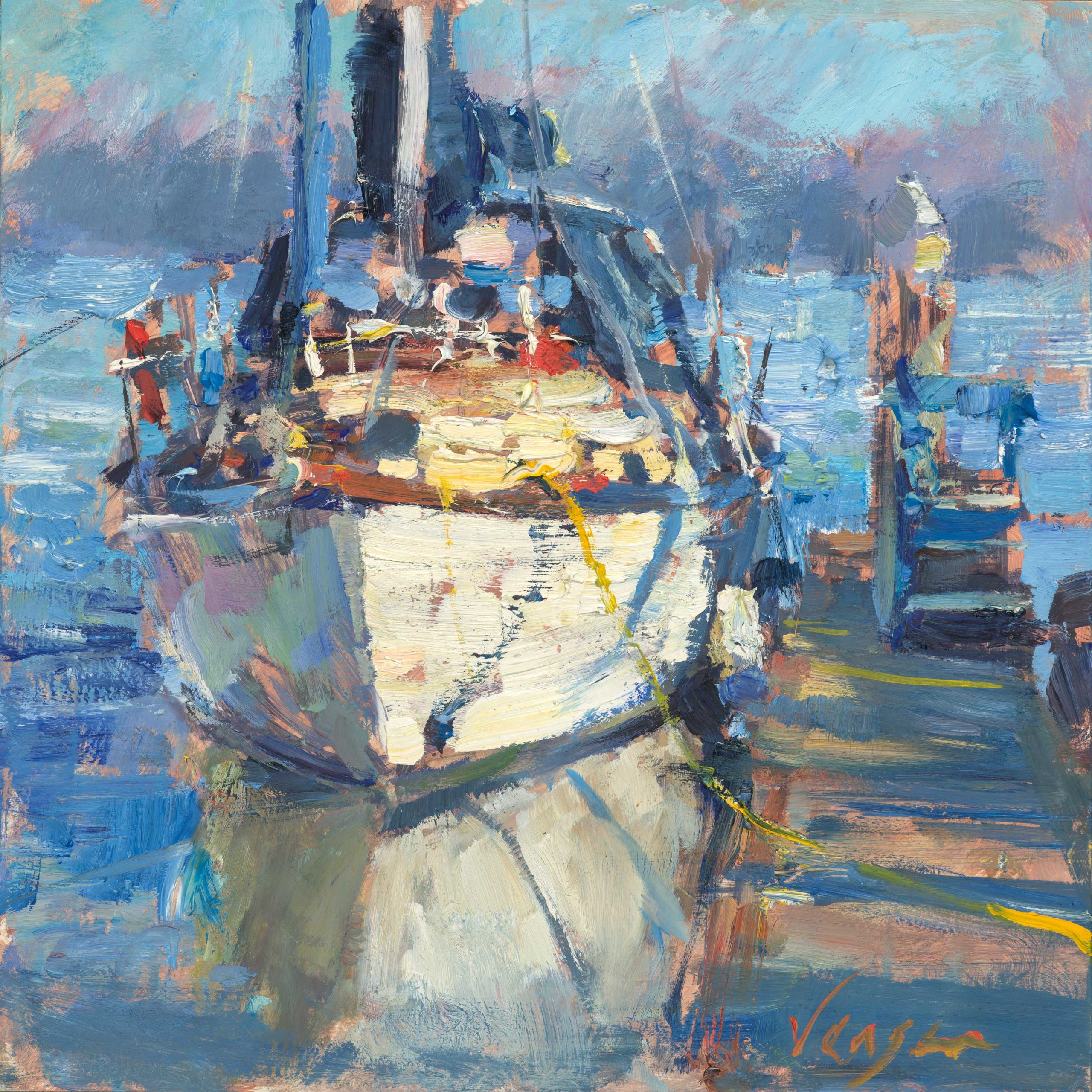
In terms of content, Jensen’s paintings seem to focus on color temperature and the atmosphere of a scene — especially scenes that feature warm light. “My subject matter changes often, which I hope doesn’t hurt me,” Jensen says. “And I hope my light is dramatic in some way and tells a story in itself. I haven’t mastered that yet, and it keeps me so hungry. I love those special areas in shadow, with cool light and warm bounce light — getting that in a painting really excites me. A mundane subject presented in a painting shows everyone what they might have missed. I hope that people can hear the birds in my painting. I hope they can smell the flowers.”
Jensen says, “I like to take chances with my work, and that means I’m happy with one out of 20 of my paintings. But I don’t want to sit and get everything perfect. That’s not me — not yet, at least.”
Connect with the artist at ryanjensenartwork.com.
Visit EricRhoads.com to find out all the amazing opportunities for artists through Streamline Publishing, including:
– Online art conferences such as Plein Air Live
– New video workshops for artists
– Incredible art retreats
– Educational and fun art conventions, and much more.
> Subscribe to Plein Air Today, a free newsletter for artists
> Subscribe to PleinAir Magazine so you never miss an issue

